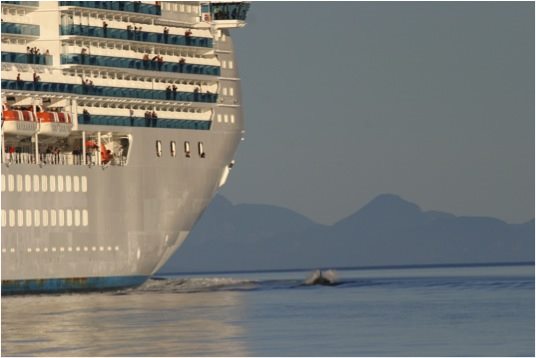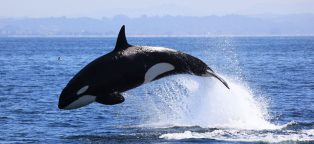Killer Whales and Ships
A report released recently suggests that the noise generated by is creating problems for killer whales and dolphins in the oceans.
It´s been long known that baleen whales are adversely affected by low frequencies. Now it is thought that high-frequency noise from ships is making it difficult for killer whales to communicate with each other and hunt for food.
A Killer Whale Next to a Cruise Liner.
 The noise from shipping is thought to disturb killer whales and dolphins to a far greater extent than was thought previously. A new study suggests that the underwater racket is harming their ability to talk to each other and hunt down food.
The noise from shipping is thought to disturb killer whales and dolphins to a far greater extent than was thought previously. A new study suggests that the underwater racket is harming their ability to talk to each other and hunt down food.
The low frequencies coming from ships has long been known as a problem for large whales. This new research suggests that medium and higher frequencies are also a problem. Orcas tend to hear in the 20,000Hz range.
Killer Whales use sound like a submarine uses sonar, to bounce off prey and locate them in the ocean. Dolphins and porpoises use a similar method and may also be affected.
The research, which you can find in PeerJ, hypothesizes that the noise could affect the endangered population of killer whales near busy shipping lanes such as Puget Sound.
The Killer Whales hunt for chinook salmon off the north-west coast of the USA- stocks are pretty scarce. To find the fish, they must listen for a click off the salmon- not easy if there is a lot of noisy shipping around.
The researchers analysed the sounds using underwater microphones to listen top and record the noise coming from around 1,600 ships as they passed through Haro Strait, in Washington state. The research went on for two years and recorded the noise coming from cruise ships, container ships and military ships.
Some ships are noisier than others but on average a ship generates 173 decibels underwater, equivalent to 111 decibels in the air. If the whales are close, that´s like standing at a rock concert. Since they are generally some way off, they are more likely to be subjected to around 70 odd decibels, which is like standing next to a Hoover.
The affect of noise upon whales is well documented (such as this research on effect of ship noise on right whales. This new work is a worrying sign that smaller whales, dolphins and porpoises are also being adversely affected.
This may be causing whales to group together more tightly in order to hear each other.
There are several knock-on consequences of a noisy marine environment. Whales may have to group together More research needs to be done to work out to what degree the noise is affecting whales and to lobby for quieter ships. In theory, reducing shipping noise is easy- the technology to do it has been around for years in the military sphere. But is costs money. Slower ships also make less noise- this is also a possibility.
Some whale species such as the North Atlantic right whale, are dangerously endangered with only 500 individuals left.
More work needs to be done to ensure that we save our whales for future generations.




